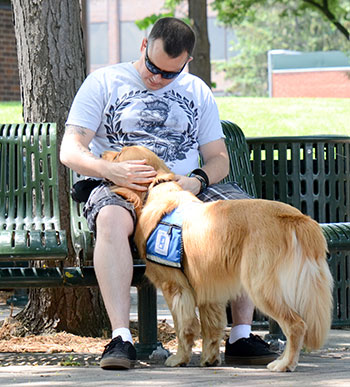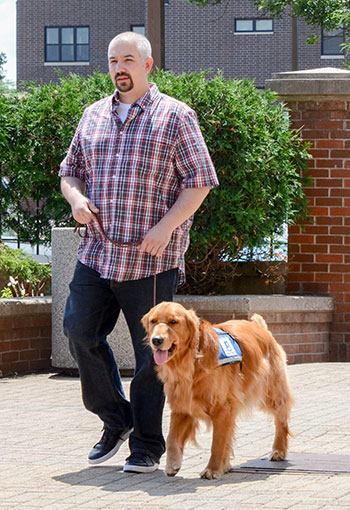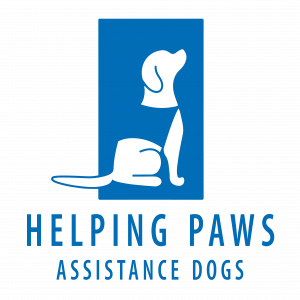Service Dogs for Veterans

[This article was originally written by volunteer Foster Home Trainer Richard Greelis and published in the StarTribune in 2015.]
Vets shouldn’t need a reason to use a service dog. People who need service dogs come in all shapes and sizes and not all of them use wheelchairs.
Someone using a service dog, whether it’s working or in training, deserves our respect. While there will always be those who abuse benefits of any kind, service dogs have come under the microscope lately. It’s important to understand the way the program works.

• “Who are all these people walking around perfectly fine with these dogs that have blue service dog ‘packs’ or vests on them?”
• “Are they really disabled or do they just like having their pet with them in public places and found this loophole?”
• “Aren’t they supposed to be in a wheelchair or something?”
You’re not alone if you’re asking yourself these questions, but please consider something before you ask the young (or old) person with the service dog why the animal is by their side:
People who need service dogs come in all shapes and sizes, and not all of them use wheelchairs.
Our country has no shortage of soldiers returning from wars fought on foreign soil who bear both visible and invisible wounds. The invisible scar, post-traumatic stress disorder (PTSD), is a real thing. Though it didn’t always bear this name, it has always been a real thing. Soldiers suffering from PTSD after World War I and World War II were called victims of “shell shock.” The Vietnam era saw PTSD for what it was and began treating vets, but the stigma of having this invisible affliction while some of their squadmates had made the ultimate sacrifice often kept sufferers from seeking treatment.

With this in mind, try to imagine a soldier first seeking help for an affliction that makes it nearly terrifying to leave home, terrifying to be in a crowd, terrifying to be exposed to loud noises, terrifying to be among strangers. He or she may have had to endure immense fear, not to mention embarrassment, just to find someone who can help with treatment.
Now imagine having this condition and hearing about a program that could allow you to re-enter society, maybe walk down a street again with confidence, and go to work, to a movie, to a church, and in the process gain a nonjudgmental constant companion who loves unconditionally and helps them with their nightmares.
Sound too good to be true? Unfortunately, it turns out it probably is for now.
Why? Because veterans with service dogs are not really accepted as truly “needing” them yet. The program is too novel. Seeing an apparently “normal” man or woman walking a service dog into a public place is just too much, too intriguing, too anomalous for some people to handle. If that seemingly normal man or woman can bring a dog to the mall, why can’t I? I think I’m going to ask what the problem is. This attitude is the killer of the service dog program for victims of PTSD. Veterans suffering PTSD are loath to explain to every curious rude-nick why they need a service dog. It is frightening, painful and embarrassing — enough so that it might turn them away from the new life of independence a service dog could offer them.

They don’t get to be nearly perfect canine citizens by practicing their skills in a vacuum.
Fully-trained (and accredited) service dogs have to experience inclusion in as many busy, loud, frenetic public settings as possible, so that when they are paired with their disabled partner they are prepared for whatever environment their disabled partner will lead them into.
So that young (or old) person walking the vested canine through the Mall of America may be a foster trainer preparing a dog for a life of service — and that dog may not have perfect manners — yet. Please respect the stitching on the dog’s vest that asks you not to pet it while it’s working. That goes for all service dogs.
I come from the ranks of the most cynical creatures walking the planet — the police. Police officers learn by necessity to question the motives of everyone they come in contact with, not necessarily to their face, but internally. This is the resulting amalgam of years of having nearly everyone they have contact with lie to them. Having lived that experience, I know that it’s natural to question the motives of those who seem out of place or seem to be cheating the system. But this is an instance where we, as a community that admires, respects and honors our veterans, need to give them the benefit of the doubt.

And finally, please don’t give them that look. Consider the sacrifice they made and go a step beyond mere adherence to the law. Welcome them into your establishment. Compliment them on their beautiful companion.
And maybe offer this silent prayer: “There but by the grace of God go I.”
Richard Greelis, of Bloomington, MN is a retired law enforcement officer, teacher and author. He can be reached by contacting Helping Paws: 952.988.9359, Extension 12.
